matlab电路仿真
matlab电路仿真教程
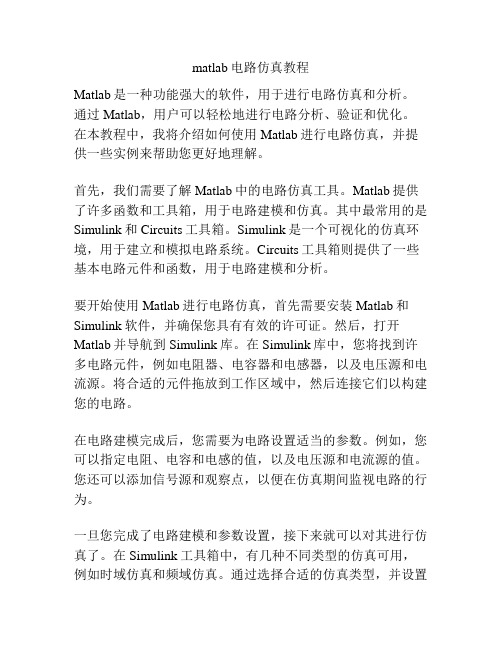
matlab电路仿真教程Matlab是一种功能强大的软件,用于进行电路仿真和分析。
通过Matlab,用户可以轻松地进行电路分析、验证和优化。
在本教程中,我将介绍如何使用Matlab进行电路仿真,并提供一些实例来帮助您更好地理解。
首先,我们需要了解Matlab中的电路仿真工具。
Matlab提供了许多函数和工具箱,用于电路建模和仿真。
其中最常用的是Simulink和Circuits工具箱。
Simulink是一个可视化的仿真环境,用于建立和模拟电路系统。
Circuits工具箱则提供了一些基本电路元件和函数,用于电路建模和分析。
要开始使用Matlab进行电路仿真,首先需要安装Matlab和Simulink软件,并确保您具有有效的许可证。
然后,打开Matlab并导航到Simulink库。
在Simulink库中,您将找到许多电路元件,例如电阻器、电容器和电感器,以及电压源和电流源。
将合适的元件拖放到工作区域中,然后连接它们以构建您的电路。
在电路建模完成后,您需要为电路设置适当的参数。
例如,您可以指定电阻、电容和电感的值,以及电压源和电流源的值。
您还可以添加信号源和观察点,以便在仿真期间监视电路的行为。
一旦您完成了电路建模和参数设置,接下来就可以对其进行仿真了。
在Simulink工具箱中,有几种不同类型的仿真可用,例如时域仿真和频域仿真。
通过选择合适的仿真类型,并设置仿真时间和步长,您可以开始执行仿真并观察电路的响应。
在仿真完成后,您可以使用Matlab绘图工具箱中的一些函数来绘制和分析电路响应。
例如,您可以绘制电压随时间的变化曲线,或者计算电源输出和负载电流之间的关系。
通过使用Matlab的分析工具,您还可以进行降阶、优化和参数估计等进一步分析。
让我们通过一个简单的示例来说明如何使用Matlab进行电路仿真。
假设我们有一个简单的RC电路,其中包括一个电阻器和一个电容器。
我们想要了解电容器的电压如何随时间变化。
matlab电路仿真教程

在MATLAB窗口的工具栏中单击
图标
在命令窗口中输入命令: >>simulink
2. Simulink浏览器
标题栏 菜单栏 工具栏 模块说明框
基本模块库
已安装专用 模块库
模块查找框 模块显示框
Simulink基本模块库包括8类子库 : Continuous(连续模块) Discrete(离散模块) Function&Tables(函数和平台模块) Math(数学模块) Nonlinear(非线性模块) Signals&Systems(信号和系统模块) Sinks(接收器模块) Sources(输入源模块)
基于MATLAB/Simulink的直流电路仿真分析
电路如图所示,参数如下:R1=2,R2=4,R3=12,R4=4,R5=12,R6=4, R7=2,Us=10V。求i3,U4,U7;
仿真结果
(2)启动仿真
启动方式: (1) Simulink模块编辑窗口菜单栏“ Simulation /Start” (2)单击工具栏上的 图标
举例说明 Sim6_1.mdl
三、Simulink常用模块介绍
在模块浏览器中的Simulink节点下包含了搭建一个Simulink模块所 需要的基本模块。本节主要对其中的Sources模块库、Sinks 模块库、 Simpower systeems模块库中的常用模块进行介绍。
输入已有的函数作为仿真的激励信号。首先要在MATLAB环境下建立一
个时间向量和相应的函数值向量,然后将时间向量和函数值向量的名称
[T, U]填入该图标的对话框中。
Sinks模块
Sinks模块库中的模块主要功能是接受信号,并且将接受的信号显示出来。
整流电路matlab仿真
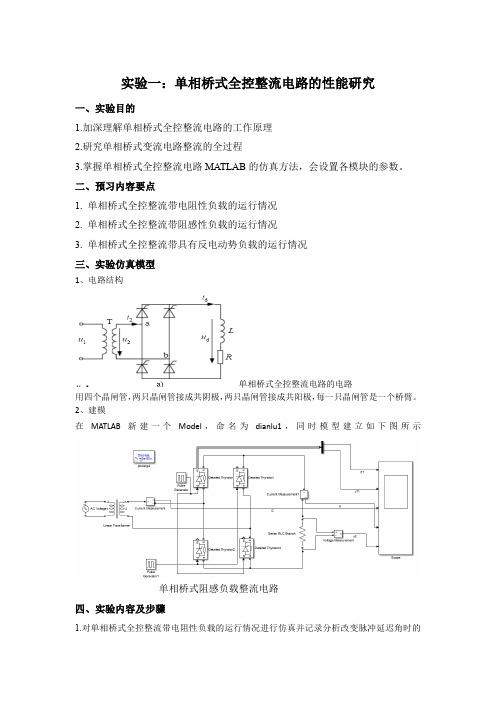
实验一:单相桥式全控整流电路的性能研究一、实验目的1.加深理解单相桥式全控整流电路的工作原理2.研究单相桥式变流电路整流的全过程3.掌握单相桥式全控整流电路MATLAB的仿真方法,会设置各模块的参数。
二、预习内容要点1. 单相桥式全控整流带电阻性负载的运行情况2. 单相桥式全控整流带阻感性负载的运行情况3. 单相桥式全控整流带具有反电动势负载的运行情况三、实验仿真模型1、电路结构单相桥式全控整流电路的电路用四个晶闸管,两只晶闸管接成共阴极,两只晶闸管接成共阳极,每一只晶闸管是一个桥臂。
2、建模在MATLAB新建一个Model,命名为dianlu1,同时模型建立如下图所示单相桥式阻感负载整流电路四、实验内容及步骤1.对单相桥式全控整流带电阻性负载的运行情况进行仿真并记录分析改变脉冲延迟角时的波形(至少3组)。
以延迟角30°为例(1)器件的查找以下器件均是在MATLAB R2014a环境下查找的,其他版本类似。
有些常用的器件比如示波器、脉冲信号等可以在库下的Sinks、Sources中查找;其他一些器件可以搜索查找(2)连接说明有时查找出来的器件属性并不是我们想要的例如:变压器可以双击变压器进入属性后,取消three windings transformer就是单相变压器。
(3)参数设置1.双击交流电源把电压设置为220V,频率为50Hz;2.双击脉冲把周期设为0.02s,占空比设为10%,延迟角设为30度,由于属性里的单位为秒,故把其转换为秒即,30×0.02/360;3.双击负载把电阻设为20Ω,电感设为0.1H;4.双击示波器把Number of axes设为5,同时把History选项卡下的Limit data points to last 前面的对勾去掉;5.晶闸管参数保持默认即可(4)仿真波形及分析1.当供电给纯电阻负载a.触发角α=0°c. α=90°从图中可以看出输出电压Ud的电压波形相对延迟角为30度时的波形向后推迟了,同理可以得出输出电压Ud的平均值变小了。
matlab电路仿真报告
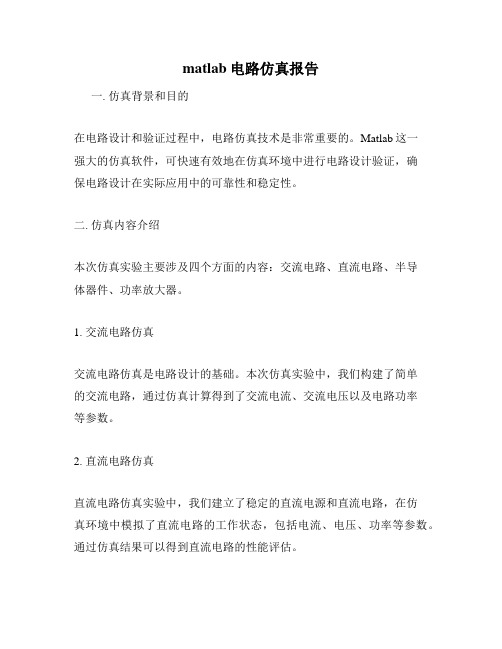
matlab电路仿真报告一. 仿真背景和目的在电路设计和验证过程中,电路仿真技术是非常重要的。
Matlab这一强大的仿真软件,可快速有效地在仿真环境中进行电路设计验证,确保电路设计在实际应用中的可靠性和稳定性。
二. 仿真内容介绍本次仿真实验主要涉及四个方面的内容:交流电路、直流电路、半导体器件、功率放大器。
1. 交流电路仿真交流电路仿真是电路设计的基础。
本次仿真实验中,我们构建了简单的交流电路,通过仿真计算得到了交流电流、交流电压以及电路功率等参数。
2. 直流电路仿真直流电路仿真实验中,我们建立了稳定的直流电源和直流电路,在仿真环境中模拟了直流电路的工作状态,包括电流、电压、功率等参数。
通过仿真结果可以得到直流电路的性能评估。
3. 半导体器件仿真半导体器件在现代电子电路中广泛应用。
本次仿真中,我们针对开关电路的应用设计了半导体管,通过仿真计算得到了开关电路在不同工作状态下的输出特性,包括开关电压、开通电流等。
4. 功率放大器仿真功率放大器是实际应用中常见的一种电路结构。
仿真实验中,我们设计了基本的功率放大器电路,在仿真环境中计算得到了频率响应、增益、输出功率等参数,用于评估该功率放大器的性能和稳定性。
三. 仿真结果分析通过仿真计算和实验结果分析,可以得出以下几点结论:1. 交流电路仿真结果表明,输入交流电源的电流和电压随时间变化而变化,同时可以计算得到电路的功率和电阻等参数。
2. 直流电路仿真结果表明,直流电路的电流和电压稳定,可以计算得到直流电路的电流、电压和功率等参数。
3. 半导体器件仿真结果表明,半导体器件可以有效地用于开关电路应用,可以计算得到器件的开通电流、开关电压等参数。
4. 功率放大器仿真结果表明,功率放大器可以在一定的频率范围内实现较大的增益和输出功率。
同时,该电路还具有一定的稳定性和可靠性。
四. 总结和展望通过对电路仿真实验的分析和总结,我们可以发现,电路仿真技术在电路设计和验证过程中具有不可替代的作用。
MATLAB电路仿真
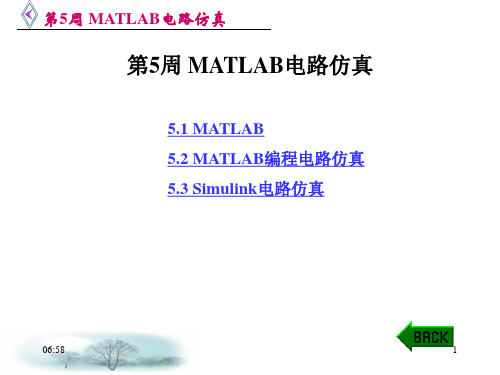
(3) 编写MATLAB 仿真程序或建立Simulink 模块方框图, 调试并运行程序。
(4)得出数值解,即仿真结果,对仿真结果进行分析,以 确定结果的可靠性和有效性。
20:24 5
第5周 MATLAB电路仿真
R + f(t ) -
L
i L(t ) + C u C(t ) -
图2-2 一个二阶电路系统
function in=f(t) %输入信号
in=(t>0)*1;%阶跃信号
20:24
10
第5周 MATLAB电路仿真 然后,利用 MATLAB 提供的求解微分方程的指令对 该微分方程组求解。 MATLAB 提供的求解微分方程的算 法有多个,如“ode45”、“ode23” 、“ ode15s” 等,不同 的算法适用的场合稍有不同。例如,通过“ ode45” 函数 求解,MATLAB程序(程序名为ex123.m)如下: 程序2-4 %filename ex123.m L=1;%电感值
%矩阵初始化
xdot(1)=-R/L*x(1)-1/L*x(2)+1/L*f(t);%方程1 xdot(2)=1/C*x(1);%方程2
function in=f(t)%输入信号
in=(t>0)*1;%信号阶跃 而ex123.m的“ode45”语句中仍然将系统状态改为[0,1]。 20:24 18 运行后得到的波形仿真结果如图 2-5所示。
20:24 15
第5周 MATLAB电路仿真 text(0.9,0.07,′\leftarrowi-L(t)′);grid; figure(2);plot(t,x(:,2));holdon;xlabel(′timesec′);
text(0.5,0.3,′\leftarrowu-C(t)′);grid;
基于Matlab的电路实时仿真平台设计与实现

基于Matlab的电路实时仿真平台设计与实现基于Matlab的电路实时仿真平台设计与实现一、引言电路仿真是电子工程领域中重要的工具之一,在电子电路设计过程中起着至关重要的作用。
而基于Matlab的电路实时仿真平台则是利用Matlab软件对电路进行仿真实验的重要应用之一。
本文将介绍基于Matlab的电路实时仿真平台的设计与实现过程。
二、电路仿真平台的设计与实现1. 平台功能需求分析基于Matlab的电路实时仿真平台的设计与实现主要包含以下功能需求:(1)电路建模:能够支持电路元件的建模以及电路的连接和布线。
(2)仿真参数设置:能够设置仿真的时间范围、步长等参数。
(3)仿真结果分析:能够实时显示电路中各个元件的电压、电流、功率等参数,并提供结果分析的功能。
(4)实验控制:能够控制实验的开始、暂停、恢复、停止等操作。
(5)数据记录与导出:能够记录仿真实验过程中的数据,并支持数据导出为Excel或其他格式。
2. 平台设计与实现基于以上功能需求,我们设计了一套基于Matlab的电路实时仿真平台。
平台的实现主要分为以下几个模块:(1)电路建模模块:利用Matlab提供的图形用户界面工具,搭建了一个电路建模界面。
用户可以通过该界面选择电路元件,并将元件进行连线和布线,从而实现电路的建模。
在建模过程中,用户还可以设置元件的参数和初始条件。
(2)仿真参数设置模块:通过设定仿真的时间范围、步长等参数,用户可以对仿真实验进行灵活的配置,以满足不同的需求。
(3)仿真运行模块:在完成电路建模和参数设置后,用户可以点击“运行”按钮,开始进行仿真实验。
平台利用Matlab强大的计算能力,根据电路模型和仿真参数进行实时的仿真计算,并实时绘制出电路中各个元件的电压、电流曲线等。
用户可以通过切换窗口或界面,实时观察仿真结果。
(4)实验控制模块:平台提供了开始、暂停、恢复、停止等操作按钮,用户可以根据需要自由控制仿真实验的进行。
例如,在观察到关键数据点时,用户可以暂停仿真实验,通过对元件参数的调整,进一步优化电路设计。
matlab电路仿真教程

三、Simulink常用模块介绍
在模块浏览器中的Simulink节点下包含了搭建一个Simulink模块所 需要的基本模块。本节主要对其中的Sources模块库、Sinks 模块库、 Simpower systeems模块库中的常用模块进行介绍。
Sources 模块
阶跃函数,起始时间是第1秒而非0秒。双击step模块,对仿真起始时间(step time)和阶跃
正弦波,电路中常用到的正弦信号(Sine Wave)模块,双击图标,在弹出的窗口中
调整相关参数。信号生成方式有两种:Time based 和 Sample based 。
从工作空间输入。从MATLAB Workspace输入已有的函数作为仿真的激
励信号。首先要在MATLAB环境下建立一个时间向量和相应的函数值向量,然后将时间向量和函数值
matlab电路仿真教程
1
Simulink简介
一、Simulink窗口环境 1. 启动Simulink
在MATLAB窗口的工具栏中单击 图标 在命令窗口中输入命令: >>simulink
2. Simulink浏览器 标题栏 菜单栏 工具栏 模块说明框
基本模块库
已安装专用 模块库
模块查找框 模块显示框
SimPower Systems模块
DC Voltage Source直流电压源,在 “Electrical Sources”模块内. Series RLC Branch 串联RLC 支路,设置参数可以去掉任一元件,将其变为单独的电阻、电容或电感 的支路。 将Series RLC Branch 模块设置成单一电阻时,应将参数:“Resistance”设 为所仿真电阻的真实值, “Inductance”设置为0,“Capacitance”设置为inf; 将Series -RLC Branch模块设置单一电感时,应将参数:“Inductance”设置为所仿真电感的真实值, “Resistance”设置为0,“Capacitance”设置为inf; 将Series RLC Branch设置单一电容时,应将参ห้องสมุดไป่ตู้: “Capacitance”设置为所仿真电感的真实值, “Resistance”和“Inductance”均设置为0。
matlab在电路分析和仿真中的应用

MATLAB/SIMULNK的主要产品及其相互关系
2024/7/15
MATLAB的优点
• 1. 容易使用 • 2. 可以由多种操作系统支持 • 3. 丰富的内部函数 • 4. 强大的图形和符号功能 • 5. 可以自动选择算法 • 6. 与其他软件和语言有良好的对接性
2024/7/15
2024/7/15
Matlab 的安装
2 输入名字和公司名称 3 在第三个空白处(PLP)输入软件的序列号sn 4 继续安装,直到安装完成。
2024/7/15
5 安装帮助 将安装目录中的help文件夹替换为安装包中的 help文件夹
MATLAB 7用户界面概述
MATLAB 7的用户界 面主要包括以下三个 方面的内容: • MATLAB 7的主菜单 • MATLAB 7的工具栏 • MATLAB 7的窗口
matlab自定义的函数文件称内置函数文件
调用内置函数的方法:使用函数名并给出相应的入 口、出口参数即可。
例如:sin.m函数——用type sin查不到。
调用格式:y=sin(2*x)
1
实际应用中:
0.8
x=0:2*pi/180:2*pi;
0.6
y=sin(2*x)
0.4
0.2
plot(x,y)
0
-0.2
2024/7/15
-0.4
-0.6
取R=255欧,L=125uH,C=6800pF,则:
H (s)
sRC s2LC sRC
1
85s2
1734000s 1734000s
1014
m文件如下: % LCR串联谐振电路 R=255; L=125*10^(-6); C=6800*10^(-12);
三阶蔡氏电路matlab仿真代码
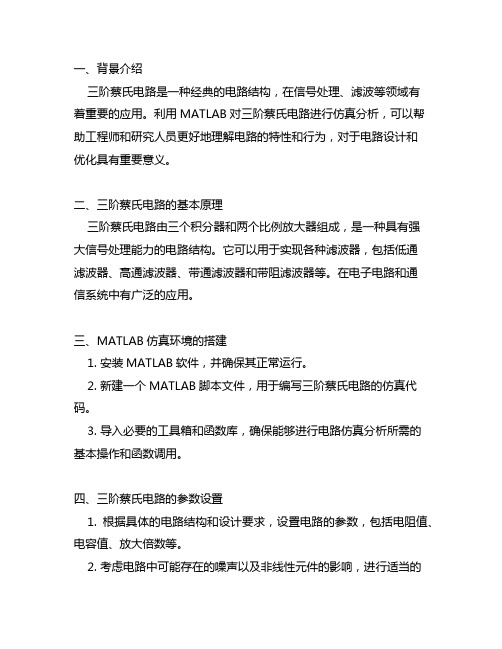
一、背景介绍三阶蔡氏电路是一种经典的电路结构,在信号处理、滤波等领域有着重要的应用。
利用MATLAB对三阶蔡氏电路进行仿真分析,可以帮助工程师和研究人员更好地理解电路的特性和行为,对于电路设计和优化具有重要意义。
二、三阶蔡氏电路的基本原理三阶蔡氏电路由三个积分器和两个比例放大器组成,是一种具有强大信号处理能力的电路结构。
它可以用于实现各种滤波器,包括低通滤波器、高通滤波器、带通滤波器和带阻滤波器等。
在电子电路和通信系统中有广泛的应用。
三、MATLAB仿真环境的搭建1. 安装MATLAB软件,并确保其正常运行。
2. 新建一个MATLAB脚本文件,用于编写三阶蔡氏电路的仿真代码。
3. 导入必要的工具箱和函数库,确保能够进行电路仿真分析所需的基本操作和函数调用。
四、三阶蔡氏电路的参数设置1. 根据具体的电路结构和设计要求,设置电路的参数,包括电阻值、电容值、放大倍数等。
2. 考虑电路中可能存在的噪声以及非线性元件的影响,进行适当的参数修正和补偿。
五、三阶蔡氏电路的MATLAB仿真代码实现1. 编写三阶蔡氏电路的节点方程,建立电路的数学模型。
2. 利用MATLAB的数值计算工具,如ode45函数等,对电路进行仿真计算。
3. 对仿真结果进行分析和后处理,得到电路的频率响应、相位特性等重要信息。
六、仿真结果与分析1. 利用MATLAB绘制三阶蔡氏电路的幅频特性曲线和相频特性曲线,观察电路的频率响应特性。
2. 对比不同参数设置下的仿真结果,分析电路性能随参数变化的规律和特点。
3. 考虑电路可能存在的非线性特性,对其进行深入分析和讨论,为实际应用提供参考依据。
七、结论与展望通过MATLAB对三阶蔡氏电路的仿真分析,我们深入了解了电路的特性和行为。
这对于电路的设计和优化具有重要意义。
在未来的研究中,可以进一步探究电路在实际应用中的性能表现,以及对其进行更加精细的仿真和分析。
也可以考虑将仿真结果与实际测试数据进行对比,验证仿真模型的准确性和可靠性。
matlab电路仿真
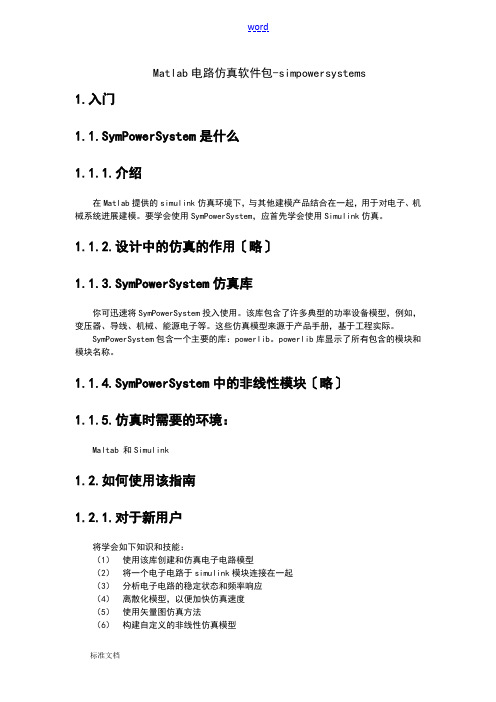
Matlab电路仿真软件包-simpowersystems1.入门1.1.SymPowerSystem是什么1.1.1.介绍在Matlab提供的simulink仿真环境下,与其他建模产品结合在一起,用于对电子、机械系统进展建模。
要学会使用SymPowerSystem,应首先学会使用Simulink仿真。
1.1.2.设计中的仿真的作用〔略〕1.1.3.SymPowerSystem仿真库你可迅速将SymPowerSystem投入使用。
该库包含了许多典型的功率设备模型,例如,变压器、导线、机械、能源电子等。
这些仿真模型来源于产品手册,基于工程实际。
SymPowerSystem包含一个主要的库:powerlib。
powerlib库显示了所有包含的模块和模块名称。
1.1.4.SymPowerSystem中的非线性模块〔略〕1.1.5.仿真时需要的环境:Maltab 和Simulink1.2.如何使用该指南1.2.1.对于新用户将学会如下知识和技能:(1)使用该库创建和仿真电子电路模型(2)将一个电子电路于simulink模块连接在一起(3)分析电子电路的稳定状态和频率响应(4)离散化模型,以便加快仿真速度(5)使用矢量图仿真方法(6)构建自定义的非线性仿真模型1.2.2.对于经验丰富的模块用户〔略〕1.2.3.所有用户〔略〕1.3.创建和仿真简单的电路1.3.1.介绍SymPowerSystem允许你对包含线性或非线性的电子电路进展建模和仿真。
在本章节中,您将学习到:(1)浏览SymPowerSystems的powerlib库(2)如何利用SymPowerSystem创建一个简单的电路(3)如何将电路与simulink模块互联。
下述电路是即将创建的电路:图1 要建模和仿真的电路1.3.2.使用powerlib创建电路(1)使用如下命令打开powerlib:powerlib(2)从powerlib的文件菜单下,允许“新建〞菜单命令,新建一个空白电路稳定,存为:circurt1(3)打开Electrical Sources库,复制其中的AC Voltage Source模块到circuit1中(4)双击AC Voltage Source,打开其属性设置对话框,按图1所示进展设置(5)改模块的名称为“Vs〞(6)将elements库中的Parallel RLC Branch模块复制到circuit1中,按图1进展参数设置(7)用同样的方法参加其他模块到电路中(8)注意参加的传输线模块:传输线模块模型图如下〔这是一段模型,一条导线通常有假如干段,每一段参数都一样,如图1所示〕:该模型是对参数分布一致的传输线的模拟。
matlab仿真电路的参数设置
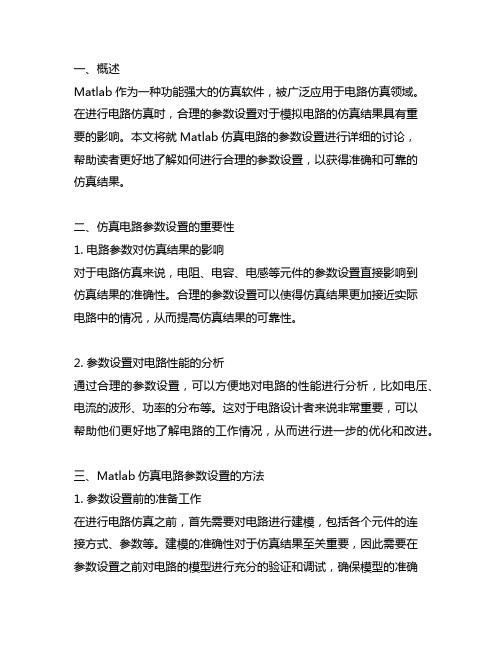
一、概述Matlab作为一种功能强大的仿真软件,被广泛应用于电路仿真领域。
在进行电路仿真时,合理的参数设置对于模拟电路的仿真结果具有重要的影响。
本文将就Matlab仿真电路的参数设置进行详细的讨论,帮助读者更好地了解如何进行合理的参数设置,以获得准确和可靠的仿真结果。
二、仿真电路参数设置的重要性1. 电路参数对仿真结果的影响对于电路仿真来说,电阻、电容、电感等元件的参数设置直接影响到仿真结果的准确性。
合理的参数设置可以使得仿真结果更加接近实际电路中的情况,从而提高仿真结果的可靠性。
2. 参数设置对电路性能的分析通过合理的参数设置,可以方便地对电路的性能进行分析,比如电压、电流的波形、功率的分布等。
这对于电路设计者来说非常重要,可以帮助他们更好地了解电路的工作情况,从而进行进一步的优化和改进。
三、Matlab仿真电路参数设置的方法1. 参数设置前的准备工作在进行电路仿真之前,首先需要对电路进行建模,包括各个元件的连接方式、参数等。
建模的准确性对于仿真结果至关重要,因此需要在参数设置之前对电路的模型进行充分的验证和调试,确保模型的准确性。
2. 参数设置的流程在进行电路仿真时,需要对每个元件的参数进行合理的设置。
一般来说,可以按照以下步骤进行参数设置:(1) 选择合适的元件模型对于不同类型的元件,Matlab提供了多种模型可供选择,比如电阻可以选择理想电阻模型、非线性电阻模型等。
需要根据实际情况选择合适的模型。
(2) 设置元件的参数根据电路的实际情况,对每个元件的参数进行设置,包括电阻的阻值、电容的电容量、电感的电感值等。
需要根据实际情况进行合理的设置,避免出现参数设置不合理的情况。
(3) 设置仿真参数在进行仿真的时候,需要设置仿真的时间、步长等参数,以获得更加详细和准确的仿真结果。
3. 参数设置的注意事项在进行参数设置时,需要注意以下几点:(1) 参数的合理性参数的设置需要符合实际的电路情况,不能盲目地进行设置。
Matlab 电力电子仿真教程.
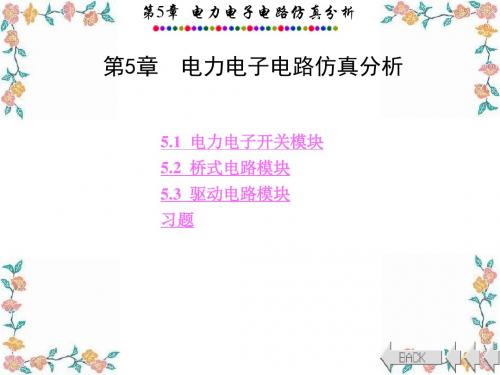
第5章 电力电子电路仿真分析
SimPowerSystems库提供的二极管模块图标如图5-3所示。
图5-3 二极管模块图标
第5章 电力电子电路仿真分析
2. 外部接口
二极管模块有2个电气接口和1个输出接口。2个电气接 口(a,k)分别对应于二极管的阳极和阴极。输出接口(m)输 出二极管的电流和电压测量值[Iak,Vak],其中电流单位为A, 电压单位为V。 3. 参数设置 双击二极管模块,弹出该模块的参数对话框,如图5-4 所示。在该对话框中含有如下参数: (1) “导通电阻”(Resistance Ron)文本框:单位为Ω,当 电感值为0时,电阻值不能为0。 (2) “电感”(Inductance Lon)文本框:单位为H,当电阻
第5章 电力电子Байду номын сангаас路仿真分析
(7) “缓冲电路阻值”(Snubber resistance Rs)文本框:并
联缓冲电路中的电阻值,单位为Ω。缓冲电阻值设为inf时将 取消缓冲电阻。 (8) “缓冲电路电容值”(Snubber capacitance Cs)文本框: 并联缓冲电路中的电容值,单位为F。缓冲电容值设为0时, 将取消缓冲电容;缓冲电容值设为inf时,缓冲电路为纯电 阻性电路。 (9) “测量输出端”(Show measurement port)复选框:选 中该复选框,出现测量输出端口m,可以观测晶闸管的电流 和电压值。 【例5.2】如图5-10所示,构建单相桥式可控整流电路,
matlab在电路仿真

a11=R1+R2; a12=-R2; a13=0; % 计算系数矩阵各元素的值
a21=-R2;a22=R2+R3+R4;a23=-R4;
a31=0;a32=-R4;a33=R4+R5+R6;
14
b1=1;b2=0;b3=0;
A=[a11,a12,a13; a21,a22,a23; a31,a32,a33];
16
17
2 含受控源的电阻电路
【例3】 如图12所示的是一个含受控源的电阻电路,设 R1=R2=R3=4、R4=2,控制常数k1=0.5、k2=4,is=2A。求i1 和i2。
18
解:方法一,M文件法。 (1) 建模。按图12列出节点方程为
1 R1
R12ua
R12ub
is
k1i2
R 12ua R 12R 13R 14 ubk1i2k R 2i3 1
matlab在电路仿真
本章学习目标
q 掌握电路系统模块集的使用 q 掌握电阻电路、电路的时域、稳态
和频域分析方法
2
主要内容
n 1 电路系统模块集简介 n 2 电阻电路 n 3 动态电路的时域分析 n 4 动态电路的稳态分析 n 5 电路的频域分析
3
1 电力系统模块集简介
电力系统模块集共有Electrical Sources、 Elements、Power Electronics、Machines、 Measurements、Application Libraries、Extras、 powergui和Demos等9个模块组。模块下面显示 的是版本号和开发该模块的公司的一些信息。
24
25
3 动态电路的时域分析
如何使用Matlab进行电路仿真与分析

如何使用Matlab进行电路仿真与分析引言:Matlab作为一种高级编程语言和数学建模工具,被广泛应用于各个领域。
在电路仿真与分析中,它可以帮助我们快速建立电路模型,并进行准确的仿真和分析。
本文将介绍如何使用Matlab进行电路仿真与分析。
一、Matlab的基本原理和优势Matlab是以矩阵运算为核心的编程语言,具有易于学习、功能强大以及丰富的工具箱等优势。
在电路仿真与分析中,Matlab可以实现电路模型的建立、节点分析、参数优化等功能,大大简化了电路设计和分析的过程。
二、电路模型的建立1. 基本元件的建模在Matlab中,我们可以使用基本元件的理想模型进行电路仿真与分析,例如电阻、电容、电感等。
通过定义电路元件的特性参数,我们可以轻松地建立电路模型。
2. 开关和放大器的建模除了基本元件,我们还可以建立开关和放大器等复杂电路元件的模型。
Matlab提供了各种模型和工具,例如理想开关模型、MOSFET模型、操作放大器模型等,可以帮助我们更准确地描述电路行为。
三、电路仿真与分析1. 网络分析法Matlab提供了丰富的网络分析工具,例如电压源、电流源、电阻、电容和电感等。
通过定义电路拓扑和元件参数,我们可以利用Matlab进行节点分析、等效电路求解、功率分析等操作,得到准确的电路行为结果。
2. 时域和频域分析除了网络分析,Matlab还支持时域和频域分析,帮助我们深入理解电路行为。
在时域分析中,我们可以观察电压和电流的波形、幅值、频率等信息;在频域分析中,我们可以计算电路的频谱、谐波失真等参数,从而评估电路性能和稳定性。
四、参数优化和曲线拟合1. 参数优化Matlab提供了各种优化算法和工具,例如遗传算法、模拟退火算法等,可以帮助我们优化电路的性能。
通过定义优化目标和约束条件,我们可以利用Matlab进行参数调整,提高电路的效率和可靠性。
2. 曲线拟合在电路设计中,我们经常需要通过试验数据来拟合曲线,以得到合适的电路模型。
matlab电路仿真代码

matlab电路仿真代码以下是一个简单的MATLAB电路仿真代码示例,演示如何使用MATLAB进行基本的电路仿真:matlab定义电路参数R = 1; 电阻值C = 1; 电容值L = 1; 电感值Vin = 1; 输入电压定义仿真参数t_start = 0; 仿真起始时间t_end = 10; 仿真结束时间dt = 0.01; 仿真步长计算仿真所需变量N = floor((t_end - t_start) / dt) + 1; 仿真步数t = linspace(t_start, t_end, N); 时间向量Vout = zeros(1, N); 输出电压向量I = zeros(1, N); 电感电流向量进行仿真for i = 2:NVout(i) = Vout(i-1) + (Vin - Vout(i-1)) * dt / (R*C); RC电路输出电压I(i) = I(i-1) + (Vin - Vout(i-1)) * dt / L; 电感电流end绘制输出结果figure;subplot(2,1,1);plot(t, Vout);title('输出电压');xlabel('时间');ylabel('电压');subplot(2,1,2);plot(t, I);title('电感电流');xlabel('时间');ylabel('电流');以上代码演示了一个简单的RC电路和电感电流的仿真。
首先定义了电路的参数,然后定义了仿真的时间范围和步长。
接下来,根据定义的参数和仿真步长计算出时间向量,以及初始化输出电压和电感电流的向量。
然后,使用一个for 循环进行仿真,根据RC电路和电感电流的公式更新输出电压和电感电流的值。
最后,使用subplot将输出电压和电感电流的结果绘制在一个图形窗口中。
请注意,上面的示例只是一个简单的电路仿真示例,实际的电路仿真可能更复杂,具体的仿真方法和计算公式取决于电路的特性和您的需求。
应用matlab电路仿真

MATLAB电路仿真
注意:
1、电阻,电容,电感的产生方法 Series RLC Branch模块的设置,可以分别产生电 阻,电容,电感
Resistance 5 0 0
Inductance 0 2 0
Capacitance inf inf 0.5
类别 电阻 电感 电容
2、此例中ac voltage source/ac current source的设 置见p97,表4-9
MATLAB电路仿真
m文件:
Clear; V=40;r=5;ra=25;rb=100;rc=125;rd=40;re=37.5; R1=(rb*rc)/(ra+rb+rc); R2=(rc*ra)/(ra+rb+rc); R3=(ra*rb)/(ra+rb+rc); Req=r+R1+1/(1/(R2+re)+1/(R3+RD)); i=v/req;
a
R3 C1
+
Us
b
R2 c
+ d
Is
L4
MATLAB电路仿真
有电路知识可知
U oc
z1
z2
z2
z4 z3 z4
U s
zeq
z1z2 z1 z2
z3 z4 z3 z4
U Is * zeq Uoc
MATLAB电路仿真
M文件仿真如下:
w
um phi
1.0000 3.1623 -18.4349
结果:i=0.5000
MATLAB电路仿真
Simulink搭建电路模型 采用专用的电路仿真模块集Power System
应用matlab数字逻辑电路仿真
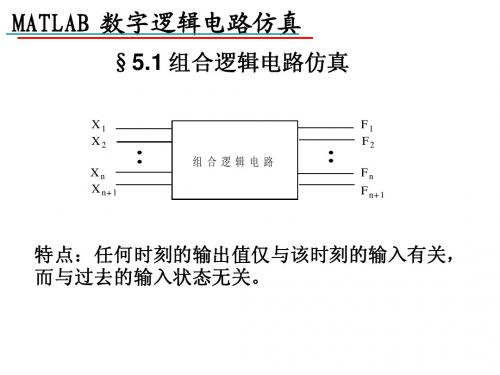
创建模型如下:
MATLAB 数字逻辑电路仿真
MATLAB 数字逻辑电路仿真
注意pulse generator模块的参数设置
模块名称 X2 X1 X0
Pulse type sample based sample based sample based
amplitud e 1 1 1
period 2 2 2
3线—8线二进制译码器真值表
X2 X1 X0 Z0 Z1 Z2 Z3 Z4 Z5 Z6 Z7
0
0 0 0 1 1
0
0 1 1 0 0
0
1 0 1 0 1
1
0 0 0 0 0
0
1 0 0 0 0
0
0 1 0 0 0
0
0 0 1 0 0
0
0 0 0 1 0
0
0 0 0 0 1
0
0 0 0 0 0
0
0 0 0 0 0
MATLAB 数字逻辑电路仿真
A=0101,B=0111实现A+B
MATLAB 数字逻辑电路仿真
§5.2 时序逻辑电路仿真
X1 Xn Z1
组 合 逻 辑 电 路
Zn
触 发 器
MATLAB 数字逻辑电路仿真
基本触发器模块: 1、RS触发器
MATLAB 数字逻辑电路仿真
RS触发器真值表
S 0 0 0 0 R 0 0 1 1 Qn 0 1 0 1 Qn+1 0 1 0 0
注意事项:
对于Pulse Generator的 属性中设置,选用 Sample based、 Amplitude=1、Period=8、 pulse width=1、 phase delay=0,1,2,3, 4,5,6,7、 sample time=1
如何利用Matlab进行模拟电路设计和仿真测试

如何利用Matlab进行模拟电路设计和仿真测试引言:在电子技术领域,模拟电路设计及仿真测试起到了至关重要的作用。
Matlab作为一款功能强大的科学计算工具,具有丰富的工具箱和扩展性,能够帮助工程师们完成复杂的电路设计和仿真测试工作。
本文将介绍如何使用Matlab进行模拟电路设计和仿真测试,以及常用的工具箱和技巧。
一、Matlab的基本特点和优势1.1 Matlab的功能和应用领域Matlab是一种基于矩阵和数组的高级数学语言和环境,具有工程计算、数据可视化、算法开发和模拟仿真等多种功能。
在电子技术领域,Matlab可以用于电路设计和仿真测试、信号处理、图像处理等方面的工作。
1.2 Matlab的优势(1)易于学习和使用:Matlab采用了类似于C语言的语法,对于熟悉编程的工程师来说非常容易入手。
(2)强大的数学计算能力:Matlab集成了丰富的数学函数和算法,可以快速处理各类数学计算任务。
(3)丰富的工具箱和扩展性:Matlab提供了各种工具箱,包括Simulink、DSP System Toolbox、RF Toolbox等,可以满足不同领域的需求。
(4)强大的图形和可视化功能:Matlab支持二维和三维图形的绘制,可以帮助工程师更直观地理解和分析数据。
(5)良好的与硬件设备的接口:通过适配器和接口,Matlab可以与硬件设备进行连接,实现数据的实时采集和控制。
二、利用Matlab进行模拟电路设计2.1 电路设计的基本流程在进行模拟电路设计之前,我们需要先明确电路设计的基本流程。
一般而言,电路设计的流程可以分为需求分析、系统规划、电路设计、电路优化和验证等几个阶段。
在Matlab中,我们可以利用其丰富的工具箱和函数来完成这些任务。
2.2 电路设计所需的Matlab工具箱在Matlab中,有几个常用的工具箱适用于电路设计,包括Signal Processing Toolbox(信号处理工具箱)、Control System Toolbox(控制系统工具箱)和Simulink(系统仿真工具箱)。
- 1、下载文档前请自行甄别文档内容的完整性,平台不提供额外的编辑、内容补充、找答案等附加服务。
- 2、"仅部分预览"的文档,不可在线预览部分如存在完整性等问题,可反馈申请退款(可完整预览的文档不适用该条件!)。
- 3、如文档侵犯您的权益,请联系客服反馈,我们会尽快为您处理(人工客服工作时间:9:00-18:30)。
C2 F Th e rm o sta t Ce lsiu s to Fa h re n he it
Indoor v s . Outdoor Te m p.
Note: model files are ASCII, so they can be opened by any text editor, or sent easily to other platforms.
ME 379M/397 Vehicle System Dynamics and Controls
Hale Waihona Puke Department of Mechanical Engineering The University of Texas at Austin
What’s in the house?
The models are formulated from a set of basic block diagram elements. These can be “grouped” into subsystems, building a multilevel model.
The Simulink environment provides a way to piece together basic elements with “algebraic” elements (e.g., summers), and there are “calculus” functions as well. The physics can either be diagrammed or embedded in function calls.
ME 379M/397 Vehicle System Dynamics and Controls
Other demos
Department of Mechanical Engineering The University of Texas at Austin
Block Diagrams for Computer Simulation: Not a new idea.
Modeling and Simulation of using Matlab/Simulink
Modeling Building and Simulation with Simulink
Updated for Spring 2001
Raul G. Longoria University of Texas at Austin Department of Mechanical Engineering
To sta rt a n d stop th e sim u la tion , u se the "S ta rt" se le ction in th e "S im ula tio n" pu ll-d own m e n u
Note: this model file pre-loads thermdat.m to set parameters.
The block diagram descriptions F.D. Ezekiel and H.M. Paynter, “Computer Representations of are effective for modeling Engineering Systems Involving Fluid Transients,” Trans. ASME, Nov. 1957. dynamic system models. Example elements: Σ = summer Π = product ∫ = integrator Φ = function (nonlinear type)
The University of Texas at Austin
algebra
Simulink Description
• Models are hierarchical. Model detail can be viewed by “diving into” blocks. • The block diagram describes the equations, and possibly the interconnection of components. • You can simulate the model choosing from several integration methods. • Analysis can be conducted in Simulink or from the MATLAB command window. It depends on whether an interactive or batch mode is desired. • Display functions are available for direct plotting (while simulation runs). • The simulation results can also be “sent” to the workspace for postprocessing and visualization using the MATLAB graphical tools. • There are many analysis tools available, and since Simulink is integrated into MATLAB, you can simulate, analyze, and revise models in either environment at any point.
– review available solvers – trim
• Tutorials:
– PMDC motor – Angular drive coil
Goal: Feel comfortable building and analyzing basic models in Simulink.
ME 379M/397 Vehicle System Dynamics and Controls Department of Mechanical Engineering The University of Texas at Austin
ME 379M/397 Vehicle System Dynamics and Controls
Department of Mechanical Engineering The University of Texas at Austin
Starting Simulink
• Simulink can be ‘launched’ from the command line: Open a model » simulink Create • Or, use the menu bar • The model browser opens • *.mdl is the extension used for Simulink models
ME 379M/397 Vehicle System Dynamics and Controls Department of Mechanical Engineering The University of Texas at Austin
ME 379M/397 Vehicle System Dynamics and Controls
a new model
Department of Mechanical Engineering The University of Texas at Austin
House Demo
Open: MATLABR11\toolbox\simulink\simdemos thermo.mdl
1 /s co st
He a t C os t ($)
70
F2 C
Te rr
blowe r cmd
he a te r QDot
Mdo t*h a He a te r Blowe r Ho use F2C Fa h re n he it to Ce lsius
Tin
Do lla r Ga in
S e t P oin t Fa hre n he it to Ce lsius
ME 379M/397 Vehicle System Dynamics and Controls Department of Mechanical Engineering The University of Texas at Austin
What is to be gained?
• Quicker modeling • Better communication • Modularity - can connect subsystems together to make more complex models
ME 379M/397 Vehicle System Dynamics and Controls
Department of Mechanical Engineering The University of Texas at Austin
Outline for Today
• Quick Intro/Demo • Physical modeling with block diagrams • Simulink modeling tools and features • Analysis Tools in Simulink
Numerical integrators
= − x + u (t ) x
ME 379M/397 Vehicle System Dynamics and Controls
1 u (t) s Inte g ra to r S co p e
e.g., u(t) = step
